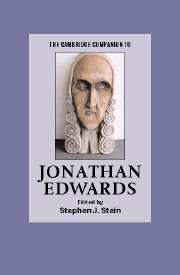Book contents
- Frontmatter
- Introduction
- Part I Edwards’s life and context
- Part II Edwards’s roles and achievements
- 5 Edwards as preacher
- 6 Edwards as revivalist
- 7 Edwards as theologian
- 8 Edwards as philosopher
- 9 Edwards as biblical exegete
- 10 Edwards as missionary
- Part III Edwards’s legacy and reputation
- The Works of Jonathan Edwards
- Further Readings
- Index
- Series List
6 - Edwards as revivalist
from Part II - Edwards’s roles and achievements
Published online by Cambridge University Press: 28 November 2007
- Frontmatter
- Introduction
- Part I Edwards’s life and context
- Part II Edwards’s roles and achievements
- 5 Edwards as preacher
- 6 Edwards as revivalist
- 7 Edwards as theologian
- 8 Edwards as philosopher
- 9 Edwards as biblical exegete
- 10 Edwards as missionary
- Part III Edwards’s legacy and reputation
- The Works of Jonathan Edwards
- Further Readings
- Index
- Series List
Summary
In a profound sense, revivals were in Jonathan Edwards's genes. Were there to be a spiritual genome, “revival ” and “Jonathan Edwards ” would make a perfect match. From his father, Timothy Edwards, he would acquire the tools and ambition to be America's greatest preacher and theologian. And from his maternal grandfather, Solomon Stoddard, he would inherit a revivalist role model without peer. When Edwards succeeded Stoddard in the wealthy and powerful Northampton, Massachusetts, pulpit, he succeeded an evangelistic legend. Under Stoddard's impassioned and terrifying preaching, Northampton residents went through five “harvests ” of mass conversions marked by sudden jumps in church membership. The challenge for young Edwards was to replicate his grandfather's achievement.
Like his grandfather, Edwards would strategize for revival, and always at the center of that strategizing would be the young people. In April 1734, the death of a young person in the congregation set off a general concern among the youth, and in the months that followed, Edwards saw “soul concerns ” spread through the town. Soon revivals spread from the youth to the adults. In all, Edwards noted, over three hundred people were savingly converted; well over two hundred were admitted into church membership in the two-year period - at one point as many as one hundred in one day. Equally pleasing to Edwards was the atmosphere of harmony and Christian behavior that prevailed in notoriously contentious Northampton. Even more encouraging were reports from nearly thirty communities up and down the Connecticut River Valley attesting to the revival spirit in their churches.
- Type
- Chapter
- Information
- The Cambridge Companion to Jonathan Edwards , pp. 125 - 143Publisher: Cambridge University PressPrint publication year: 2006
- 2
- Cited by



